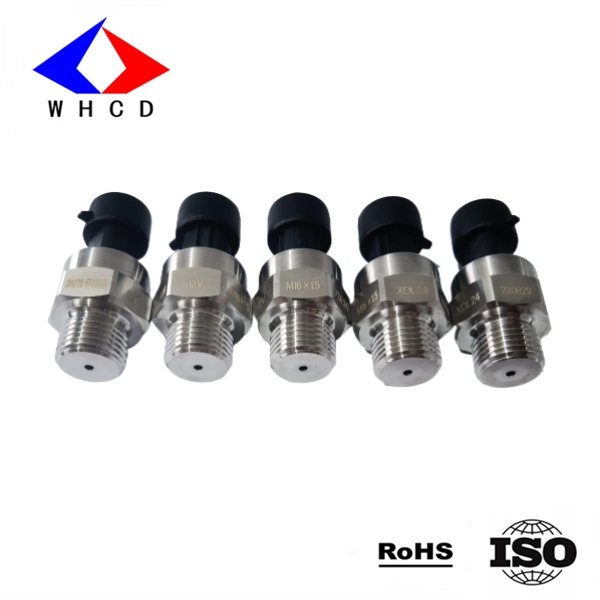Due to the uneven level of the automobile pressure sensor on the market at present, how do we choose and identify the function and quality of the auto pressure sensor? Let’s talk about the performance parameters of the pressure sensor as below:
Pressure sensor refers to the device that can feel the pressure and convert the pressure change into electrical signal output. It is the most common kind of sensor in automatic equipment, and also the nervous system in automatic force measuring equipment. The correct use of pressure sensor must first understand the automobile pressure sensor parameters.
the mainly parameters of Autopressure sensor as follows:
1、Load rating of the pressure sensor:The general unit is Bar, Mpa, etc. If the measuring range is 10Bar, the measuring range of the sensor is 0-10 bar 0-1.Mpa.
2、The operating temperature range refers to the temperature range in which the performance parameters of the pressure sensor can be used without permanent harmful changes.
3、Temperature compensation range : that in this temperature range, the rated output and zero balance of the sensor are strictly compensated, so as not to exceed the specified range.
4、Temperature effect on zero:The influence of zero point temperature refers to the influence of ambient temperature change on the zero point of pressure sensor. Generally, it is expressed as the percentage of the zero equilibrium change caused by every 10℃ temperature change to the rated output, and the unit is: %F.S./10℃.
5、sensitivity Temperature effect on out: Sensitivity temperature drift refers to the change of the sensitivity of the pressure sensor caused by the change of the ambient temperature. Generally, it is expressed as the percentage of rated output of sensitivity change caused by a temperature change of 10℃, and the unit is: F.S./10℃.
6、Rated output: the output signal coefficient of the pressure sensor, the unit is mV/V, common 1mV/V, 2mV/V, full scale output of the pressure sensor = working voltage * sensitivity, for example: Working voltage 5VDC, sensitivity 2mV/V, full range output is 5V*2mV/V=10mV, such as pressure sensor full range of 10Bar, full pressure of 10Bar, output is 10mV, pressure of 5Bar is 5mV.

7、Safe Load Limit: Safe load limit means that it will not cause destructive damage to the pressure sensor within this load, but it cannot be overloaded for a long time.
8: Ultimate overload: refers to the limit value of the load of the pressure sensor.
9. Non-linearity: Linearity refers to the percentage of maximum deviation between linear and measured curve of load increase against rated output, determined by output value of empty load and rated load. In theory, the output of the sensor should be linear. In fact, it is not. The nonlinearity is the percentage deviation from the ideal. The nonlinear unit is: %FS, nonlinear error = range * nonlinear, if the range is 10Bar and the nonlinear is 1%fs, the nonlinear error is: 10Bar*1%=0.1Bar.
11:Repeatability: error refers to the repeated loading of the sensor to the rated load and unloading under the same environmental conditions. The percentage of the maximum difference between the output value and the rated output at the same load point during loading.
12:Hysteresis: refers to the gradual loading of the pressure sensor from no load to rated load and then gradual unloading. The maximum difference between loaded and unloaded outputs at the same load point as a percentage of the rated output.
13:Excitation voltage: refers to the working voltage of the pressure sensor, which is generally 5-24VDC.
14:Input resistance: refers to the resistance value measured from the input end of the pressure sensor (red and black lines for automotive pressure sensors) when the signal output end is open and the sensor is not pressurized
15: Output resistance: refers to the resistance measured from the signal output when the pressure sensor input is short circuited and the sensor is not pressurized.
16: Insulation impedance: refers to the DC impedance value between the circuit of the pressure sensor and the elastomer.
17: Creep : refers to the percentage of the change in the output of the pressure sensor over time to the rated output, which is generally 30min, under the condition that the load remains unchanged and other test conditions remain unchanged.
18: zero balance :The output value of the pressure sensor as a percentage of the rated output at the recommended voltage excitation when unloaded. In theory, the output of the pressure sensor should be zero when it is unloaded. In fact, the output of the pressure sensor is not zero when it is unloaded. There is a deviation, and the zero output is the percentage of the deviation.
The above is an overview of the parameters of the automobile pressure sensor. If you have any advice, please feel free to leave a comment,Our pressure sensor factory look forward to establishing a stable and long-term cooperative relationship in anytime.
Post time: Apr-10-2023

